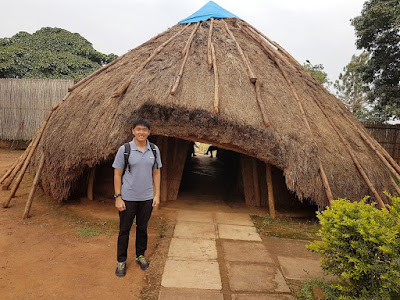JPN: Senso-ji
2-3-1 Asakusa, Taito, Tokyo, Japan
[Temple Grounds] Daily: 24 hours
[Main Hall] Daily: 6.00am - 5.00pm
Senso-ji, also known as Asakusa Kannon Temple, is Tokyo's oldest Buddhist temple. The construction of the temple was completed in 645. It's dedicated to Kannon Bosatsu, the Bodhisattva of compassion. Formely associated with Tendai Buddhism, it became independent after World War II.
---
SIN: British Airways Lounge @ Changi Airport
JPN: Japan Airlines JL36 (Business)
JPN: Hotel Listel Shinjuku
JPN: Meiji Jingu
JPN: Yoyogi Park
JPN: Pokémon Center Tokyo DX & Pokémon Café
JPN: Toyosu Market
JPN: Inokashira Park
---
My BFF and I took a train to Asakusa railway station. From there, it's a short walk to the frequently photographed Kaminarimon, the outer gate of the temple.
 |
| Kaminarimon is the symbol of Asakusa, as well as the entire city of Tokyo. |
Have fun checking out the lively shopping street called Nakamise-dori after passing through Kaminarimon (lit. Thunder Gate).
 |
| The shopping street stretches over 250 m with most shops operating from 10.00am to 5.00pm. |
 |
| Do you have an 'I Love Japan' T-shirt? |
 |
| The inviting aroma of sweet potato-based goods from Funawa was wafting in the air. |
There are more shops along other streets that branch out of Nakamise-dori, but we didn't check them out.
At the end of Nakamise-dori is Hozomon (lit. Treasure House Gate), the inner gate of the temple.
 |
| As the name suggests, the second storey of the gate is a treasury. |
 |
| That's one of the two statues of Nio, the guardian deities of the Buddha. |
There's a stately five-storey pagoda in the vicinity.
Unfortunately, the temple had closed by the time we arrived, so we didn't get to see the interior.
 |
| The original temple was destroyed during World War II. Its rebuilding is a symbol of rebirth and peace. |
 |
| Senso-ji is the focus of Sanja Matsuri, which is Tokyo's largest and most popular festival held in late spring. |
Last year saw me trying omikuji, a type of Japanese fortune-telling that can be found at temples and shrines throughout the country.
 |
| After donating ¥100 (~S$1.30), I drew a a numbered stick from the metal container and proceeded to take a piece of the fortune paper from the correct drawer. |
 |
| Yay! Since I got a kichi (lit. blessing), I got to bring the paper home. In the event of a bad luck, tie the paper to a pine tree. |
Perhaps the operating hours of the temple shop selling amulets are the same as the opening hours of the main hall.
 |
| That's the water ablution pavilion, but the fountain was turned off and the ladles weren't there as the main hall had closed for the day. |
 |
| Still so lively even after 6.30pm! |
 |
| Tokyo Skytree can be seen from the temple premise. |
I was so happy when I saw a vending machine selling hot amazake (Japanese sweet, non-alcoholic fermented rice wine). I quickly reached for my coin wallet and got a can for myself.
Before leaving, we saw a big map of the premise.
This most widely visited spiritual site in the world is said to receive over 30 million visitors annually, though the figure is definitely much smaller this year due to COVID-19.































Comments
Post a Comment